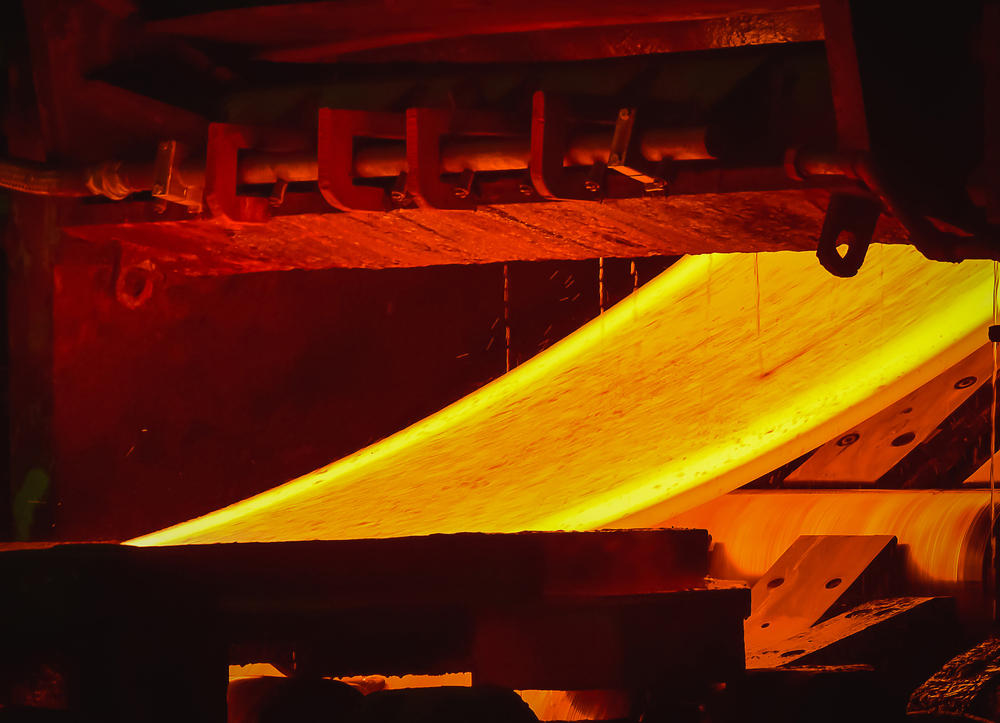HOT ROLLED STEEL VS. COLD ROLLED STEEL
June 15, 2021 | Categorized in: Types

Rolled steel is categorized by the temperature and processing it goes through, usually dependent on its use and purpose in a construction or manufacturing project. The variety of applications is helped by the vast number of different steel grades and shapes as well. Not only do the grades, sizes, and chemical makeup of steel products determine what they can be used for, but also the processing can make it more suitable for a certain project or situation.
What is rolled steel?
Rolling steel involves running the metal through a pair, or pairs, of rollers to flatten and thin out the steel, or to make the thickness more uniform. This can be done using one pair of rollers, but usually uses three to six pairs that gradually reduce the thickness of the steel. The general reason for rolling steel is largely dimension specifications and to get a piece of steel that is thin enough for its desired application. However, there are differences in the processes for actually accomplishing this.
Hot vs. cold rolled steel
Hot Rolled Steel
As one might have assumed, the primary difference between hot and cold rolled steel is the temperature at which the manufacturing process occurs. Hot rolled steel is processed at over 1,700°F and is easier to work with because, although steel gets red hot at 900°F, it recrystallizes between 750°F and 1,300°F. This means it can be reshaped and altered before it hardens again. Requiring less processing and force to manipulate the material means that it’s less labor-intensive and more cost-effective – but, there are some drawbacks.
Steel will shrink as it cools and because this is unpredictable, the amount and direction the steel shrinks can mean that final sizes and dimensions are difficult to plan for. In addition to the measurements, hot rolled steel will also have flaky scaling on the surface that needs to be removed through grinding, sandblasting, or acid-bath pickling to get a clean finish.
Cold Rolled Steel
On the other hand, cold rolling steel actually occurs after hot rolling – the steel is allowed to cool to room temperature and then further processed without more heat (hence the “cold” rolled steel). As a result, cold rolled steel is not only much more accurate in terms of dimensions because it doesn’t cool and shrink further, but also has a smooth surface finish. Even better, cold rolled steel’s tensile and yield strength can be increased by around 25% (or even 40-50% in certain situations) greater than hot rolled steel.
Of course, with so many benefits there are going to be downsides, the primary one being cost. The extra processing that cold steel requires means that it’s much more labor-intensive and significantly more expensive.
Major Differences Between Cold Rolled & Hot Rolled Steel
The most significant difference between these two is that hot rolling can get a roughly accurate and thin piece of steel that is functional but much less refined. With cold rolling, an extra processing step is added that improves the dimensional accuracy, overall strength, and visual aesthetics of the steel. However, cold rolled steel can still rust, and might benefit from being galvanized after being produced to prevent oxidation. Because of the extra resources and time that are spent, cold rolling is, unsurprisingly, going to be more expensive as well.
Cold Drawn Steel vs. Colled Rolled Steel
Much like cold rolling, cold drawing is a secondary manufacturing process that takes place after hot rolling. In contrast, the cooled steel is passed through a die rather than rollers. A die is a machine that pulls or pushes a lubricated steel wire (or bar) through a funnel-like opening, compressing the product while altering its shape. Additionally, while cold rolled steel is generally a flat, wide product, cold drawn steel is a long, thin product. The process, just like cold rolling, increases the tensile and yield strength of the steel while leaving a burnished surface.
To suit the needs of a specific project, the cross-section of cold drawn steel can be round, rectangular, hexagonal, or even octagonal. Due to their versatility and strength, these types of products are used in a range of industries; from the automotive industry for wheel spokes or steering shafts to the agricultural industry for auger wires or power springs. Cold drawn steel can also be more cost-effective than cold rolled; although, that all depends on how many iterations of dies the material needs to pass through.
Which is Right for You?
Depending on your project, certain aspects may push you towards hot rolled or cold rolled steel. If the look and feel of the steel doesn’t matter, hot rolling might be the best choice so you don’t have to pay for extra, unnecessary processing. If the steel does have to look presentable, extra strength is needed, or the size specifications of the pieces of steel are very precise, then the extra money spent on cold steel is probably worth it. It all comes down to what your project involves and what the steel is being used for. If you want assistance choosing steel shapes that fit your needs, reach out and get a quote today!
